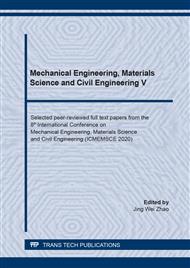p.13
p.18
p.24
p.31
p.40
p.49
p.56
p.61
p.69
Numerical Analysis of Stray Grain Formation during Laser Welding Nickel-Based Single-Crystal Superalloy Part III: Crystallography-Dependent Solidification Behavior
Abstract:
The solidification temperature range was numerically analyzed to optimize nonequilibrium solidification behavior during ternary Ni-Cr-Al nickel-based single-crystal superalloy weld pool solidification with variation of laser welding conditions (either heat input or welding configuration). The distribution of solidification temperature range along the fusion boundary is beneficially symmetrical about the weld pool centerline in the (001)/[100] welding configuration. The distribution of solidification temperature range along the fusion boundary is detrimentally asymmetrical about the weld pool centerline in the (001)/[110] welding configuration. The stray grain formation and solidification cracking are preferentially confined to [100] dendrite growth region. [001] epitaxial growth region with columnar dendrite morphology is favored at the expense of undesirable [100] growth region with equiaxed dendrite morphology to facilitate essential single-crystal solidification with considerable reduction of heat input. The smaller heat input is used, the narrower solidification temperature range is thermodynamically promoted to reduce nucleation and growth of stray grain formation with decrease of constitutional undercooling ahead of dendrite tip and mitigate thermo-metallurgical factors for morphology instability and microstructure anomalies. Potential low heat input(both decreasing laser power and increasing welding speed) with (001)/[100] welding configuration decreases solidification temperature range to significantly minimize columnar/equiaxed transition (CET) and stray grain formation, and improve resistance to solidification cracking through microstructure control. On both sides of weld pool are imposed by the same heat input, while the solidification temperature range along the fusion boundary inside of [100] dendrite growth region on the right part of the weld pool is spontaneously wider than that of [010] dendrite growth region on the left part to increase solidification cracking susceptibility in the (001)/[110] welding configuration. Furthermore, another mechanism of solidification cracking as consequence of severe solidification behavior and anomalous microstructure with asymmetrical crystallographic orientation is therefore proposed. The theoretical predictions are well verified by experiment results. The useful and satisfactory numerical modeling is also available for other single-crystal superalloys during successful laser repair process without stray grain formation.
Info:
Periodical:
Pages:
40-48
Citation:
Online since:
June 2021
Authors:
Price:
Сopyright:
© 2021 Trans Tech Publications Ltd. All Rights Reserved
Share:
Citation:


